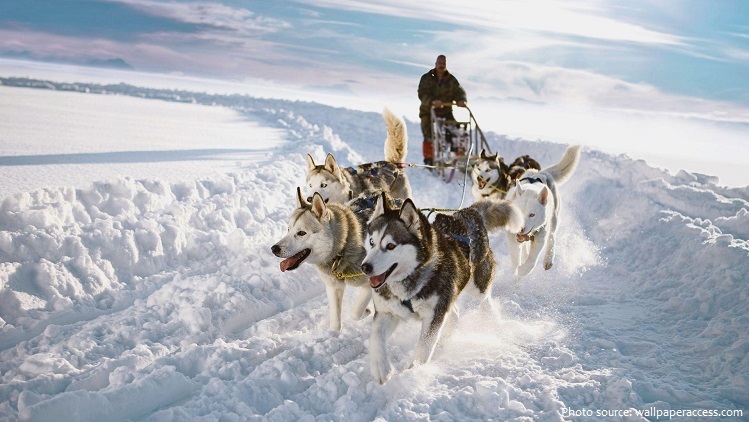Welcome to pet Friday! Today we are going to look at sled dogs from justfunfacts.com.
"A sled dog is a dog used in Arctic climates to pull a sled across snow and ice.
The breeds most commonly associated with this work are the Siberian husky, Alaskan Malamute, Samoyed, Eskimo dog, and Laika — all large, powerful dogs with thick coats and high endurance.
The original sled dogs were chosen for size, strength and stamina, but modern dogs are bred for speed and endurance.
Most sled dogs weigh around 25 kg (55 lb), but they can weigh as little as 16 kg (35 lb), and can exceed 32 kg (71 lb).
Sled dogs have a very efficient gait, and “mushers strive for a well balanced dog team that matches all dogs for both size (approximately the same) and gait (the walking, trotting or running speeds of the dogs as well as the ‘transition speed’ where a dog will switch from one gait to another) so that the entire dog team moves in a similar fashion which increases overall team efficiency.” They can run up to 45 km/h (28 mph). Because of this, sled dogs have very tough, webbed feet with closely spaced toes. Their webbed feet act as snow shoes.
Sled dogs have been used in the Arctic for at least 8,000 years and, along with watercraft, were the only transportation in Arctic areas until the introduction of semi-trailer trucks, snowmobiles and airplanes in the 20th century.
There are historical references to dogs used by Native American cultures dating back to before the first Europeans made land. There were two main types of sled dogs: one kept by coastal cultures and the other by people living in the interior. In the mid-1800s Russian traders following the Yukon River inland and acquired sled dogs from the villages along its shores.
Sled dogs were used to deliver the mail in Alaska during the late 1800s and early 1900s. Alaskan Malamutes were the favored breed, with teams averaging eight to 10 dogs. Dogs were capable of delivering mail in conditions that would stop boats, trains, and horses.
The first Arctic explorers were men with sled dogs. Due to the success of using sled dogs in the Arctic, it was thought they would be helpful in the Antarctic exploration as well, and many explorers made attempts to use them. Sled dogs were used until 1992, when they were banned from Antarctica by the Protocol on Environmental Protection to the Antarctic Treaty over concerns that the dogs might transfer diseases such as canine distemper to the seal population.
In 1925, a massive diphtheria outbreak crippled Nome, Alaska. There was no serum in Nome to treat the people infected by the disease. There was serum in Nenana, but the town was more than 970 km (600 mi) away, and inaccessible except by dog sled. A dog sled relay was set up by the villages between Nenana and Nome, and 20 teams worked together to relay the serum to Nome. The serum reached Nome in six days.
The Iditarod Trail was established on the path between these two towns. It was known as the Iditarod Trail because, at the time, Iditarod was the largest town on the trail.
The modern Iditarod is a 1,800 km (1,100 mi) endurance sled dog race. It usually lasts for ten to eleven days, weather permitting. It begins with a ceremonial start in Anchorage, Alaska on the morning of the first Saturday in March, with mushers running 32 km (20 mi) to Eagle River along the Alaskan Highway, giving spectators a chance to see the dogs and the mushers. The teams are then loaded onto trucks and driven 48 km (30 mi) to Wasilla for the official race start in the afternoon. The race ends when the last musher either drops out of the race or crosses the finish line in Nome. The winner of the race receives a prize of US$50,000. It has been billed as the “World Series of mushing events” and “The Last Great Race on Earth”.
The Alaskan Gold Rush brought renewed interest in the use of sled dogs as transportation. Most gold camps were accessible only by dogsled in the winter. “Everything that moved during the frozen season moved by dog team – prospectors, trappers, doctors, mail, commerce, trade, freighting of supplies … if it needed to move in winter, it was moved by sled dogs.” This, along with the dogs’ use in the exploration of the poles, led to the late 1800s and early 1900s being nicknamed the “Era of the Sled Dog”.
Sled dog teams delivered mail to rural communities in Alaska, Yukon, Northwest Territories and Nunavut.
Sled dogs today are still used by some rural communities, especially in areas of Russia, Canada, and Alaska as well as much of Greenland. They are used for recreational purposes and racing events, such as the Iditarod Trail and the Yukon Quest.
Sled dog racing is a winter dog sport most popular in the Arctic regions of the United States, Canada, Russia, Greenland and some European countries. It involves the timed competition of teams of sled dogs that pull a sled with the dog driver or musher standing on the runners. The team completing the marked course in the least time is judged the winner.
A sled dog race was a demonstration sport at the 1932 Winter Olympics in Lake Placid, New York and again at the Olympics in Oslo, and once more in the 1994 Winter Olympics in Lillehammer, but it did not gain official event status.
The most commonly used dog in dog sled racing, the Alaskan husky is a mongrel bred specifically for its performance as a sled dog.
Sled dog racing is Alaska’s official state sport. The Iditarod is the best-known race but there are dozens of dog races that take place during Alaska winters. Once a basic form of transportation, this popular activity has evolved into a recreational and competitive activity for both residents and tourists. Here’s more about how dog mushing became Alaska’s favorite sport!"
I am very impressed by these dogs and what they can do.
Reference: http://justfunfacts.com/interesting-facts-about-sled-dogs/
I have lost a lot of faith with the Medical Community and the Governments over the last several years, but there are a few good things that can raise above the corruption and the pushing of drugs a new approach to heal people. The following is from www.gaia.com and written by Hunter Parsons that does not involve any drug or pushing an ineffective so called vaccine that the drug company is not held accountable in any way but they use sound! The use of sound can regrow bone tissue! Here is the story:
"The future of regenerative medicine could be found within sound healing by regrowing bone cells with sound waves.
The use of sound as a healing modality has an ancient tradition all over the world. The ancient Greeks used sound to cure mental disorders; Australian Aborigines reportedly use the didgeridoo to heal; and Tibetan or Himalayan singing bowls were, and still are, used for spiritual healing ceremonies.
Recently, a study showed an hour-long sound bowl meditation reduced anger, fatigue, anxiety, and ...
Not a fan of a Defense Agency studying Anti-Gravity and other Exotic Tech, but if the commercial world and make this technology cheap that will change our world yet again. The following is about three minute read and from www.gaia.com. The below was written by Hunter Parsons:
"Wormholes, invisibility cloaks, and anti-gravity — it’s not science fiction, it’s just some of the exotic things the U.S. government has been researching.
A massive document dump by the Defense Intelligence Agency shows some of the wild research projects the United States government was, at least, funding through the Advanced Aerospace Threat Identification Program known as AATIP.
And another lesser-known entity called the Advanced Aerospace Weapons System Application Program or AAWSAP
The Defense Intelligence Agency has recently released a large number of documents to different news outlets and individuals who have filed Freedom of Information Act requests.
Of particular interest are some 1,600 pages released to Vice News, which ...
As our technology gets better we are discovering more about the history of mankind and pushing the timeline back further and further. The following article is from www.gaia.com and written by Michael Chary that discusses this new find that changes the historical timeline:
"Over the past decade, there have been a number of archeological revelations pushing back the timeline of human evolution and our ancient ancestors’ various diasporas. Initially, these discoveries elicit some resistance as archeologists bemoan the daunting prospect of rewriting the history books, though once enough evidence is presented to established institutions, a new chronology becomes accepted.
But this really only pertains to the era of human development that predates civilization — the epochs of our past in which we were merely hunter-gatherers and nomads roaming the savannahs. Try challenging the consensus timeline of human civilization and it’s likely you’ll be met with derision and rigidity.
Conversely, someone of an alternative...
Not sure if you have heard of a show on YouTube called "The Why Files". If not you should check it out it is interesting and has some humor with it on different subjects. Last weeks was on a different theory how the Universe works and how main stream Science is attempting to shut it down like is always seems to do if it goes aguest some special interest. Today it is akin to what happened to those who questioned the Earth was the Center of the Universe that main stream so called Science all believed during the Renaissance period, They called any theory that the Earth was not the Center of the Universe misinformation. Does this sound familiar today? People laughed and mocked people like Leonardo da Vinci, Nicolaus Copernicus, Georg Purbach as crack-pots, conspiracy theorists, nut-jobs and they were suppressed and even imprisoned for their radical thoughts and observations. Again it sounds like today in so many ways. In any event this is a good one to ponder and see even if a bad idea ...
Seemingly chaotic systems like the weather and the financial markets are governed by the laws of chaos theory.
We all have heard about chaos theory, but if you have not or have forgotten what chaos theory is well here you go from interestingengineering.com:
"Chaos theory deals with dynamic systems, which are highly sensitive to initial conditions, making it almost impossible to track the resulting unpredictable behavior. Chaos theory seeks to find patterns in systems that appear random, such as weather, fluid turbulence, and the stock market.
Since the smallest of changes can lead to vastly different outcomes, the long-term behavior of chaotic systems is difficult to predict despite their inherently deterministic nature.
As Edward Lorenz, who first proposed what became commonly known as the Butterfly Effect, eloquently said, "Chaos: When the present determines the future, but the approximate present does not approximately determine the future.""
You may have heard the term about chaos theory as a butterfly flaps its wings in Brazil,...
I for one have lost trust in Medical Doctors due to COVID and reflection that they seem to push pills for everything and untested so called vaccines that is using a unproven technology because the Government and the Medical Boards of the State told them to. There are a very few exceptions. Thus they do not address the key problem just prescribe more and more pills to keep you alive an sick longer for them and Big Phama to profit from you. Will AI do any better? Well that depends on what was used for the training of AI. If it also pushes pills and vaccines without question then you have the same problems noted above. However, if the AI Training includes all possible forms of treatment and they zero in on the right issues for the true problem then there is possibilities they would be way better than most of the current Medical Doctors today.
The following is from an article from interestingengineering.com and written by Paul Ratner:
"A new study looks at how accurately AI can diagnose patients. We interview the researcher, who weighs in on AI's role ...




























